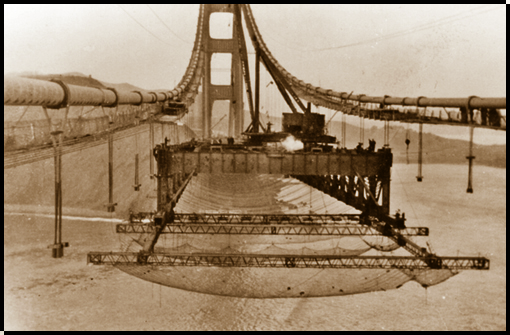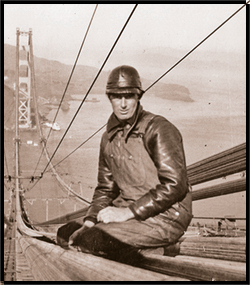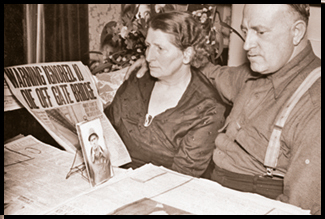by Amy Standen | Images courtesy of Labor Archives and Research Center
They pulled off a stupendous feat of engineering and design that has been called one of the seven wonders of the modern world. Meet the working-class heroes who built the Golden Gate Bridge.

IPAD EXTRA: Listen to the Labor Archives and Research Center's interviews with the workers who risked their lives hundreds of feet above the churning waters of the San Francisco Bay. Photos courtesy of Labor Archives and Research Center.
When it opened in 1937, the Golden Gate Bridge was the longest suspension bridge ever built, constructed in one of the world's most challenging settings. For the men who poured the concrete and drove in each steel rivet, it was a life-changing experience.
In many ways, Fred Brusati was typical of the kinds of men who worked building the bridge. His parents had emigrated from Milano, Italy to Montana, where Fred's father worked as a copper miner. After Fred was born in 1911, his parents moved to San Rafael. Fred spent a year in high school and then went looking for work.
"One day I heard they were going to start the Golden Gate Bridge," he told interviewer Harvey Schwartz in 1987, as part of an oral history project conducted by SF State's Labor Archives and Research Center (www.library.sfsu.edu/larc).
"And I says, 'Well, I'll try it. I never been up 746 feet, but I'll try it anyhow.'"

Tough Work in Tough Times
It was the middle of the Great Depression. Mary Currie, a spokeswoman for the Golden Gate Bridge District, says landing a job on the Golden Gate Bridge was like winning the lottery. "The men would line up and wait for a chance to get a job, literally hoping someone would hurt themselves so they'd be the one to get the job."
Slim Lambert, a cowboy from Washington state, was hired as a roustabout. He helped build a temporary railway to carry equipment across the bridge span, making about $10 a day.
"Things were a lot different in those days," he told Schwartz. "You hardly ever slowed down to a trot. If you went to the restroom and stayed more than 30 seconds, the boss would come see what was wrong with you. Lots of men were fired right on the spot, if the boss thought they were malingering a little bit. There was men waiting right there for a job."

Construction Challenges
Construction of the Golden Gate Bridge marked the first time anyone had built a suspension bridge support with a tower in the open ocean. The conditions, above and below the water, were harsh. Divers faced powerful currents as they helped anchor the massive concrete bridge support onto the ocean floor. And up on the towers, workers stuffed newspapers in their jackets to keep warm.
The bridge was "the coldest place I've ever worked," said Martin Adams, a laborer from Arkansas. "You put all the clothes on you had and worked, worked hard or you'd freeze."
Cold was the least of their concerns. Currie says workers on the bridge didn?t just fear death; they expected it. "At the time, the industry standard was that for every million dollars spent, there would be a loss of life."
Construction of the bridge was estimated to cost $35 million. But structural engineer Joseph Strauss, who headed the project, was determined to keep workers safe. Hard hats were required, and Strauss insisted on one feature that Currie says was, at the time, completely novel: a safety net. "It was a $130,000 expense at the time, which was considered an exorbitant expense. But he really fought for it and was able to get the board of directors to permit it."
See more of Life on the Gate
Alumni artists' visions of the Golden Gate Bridge